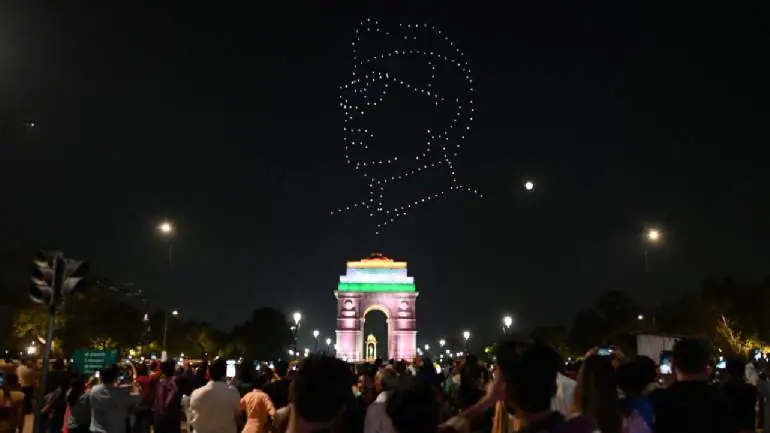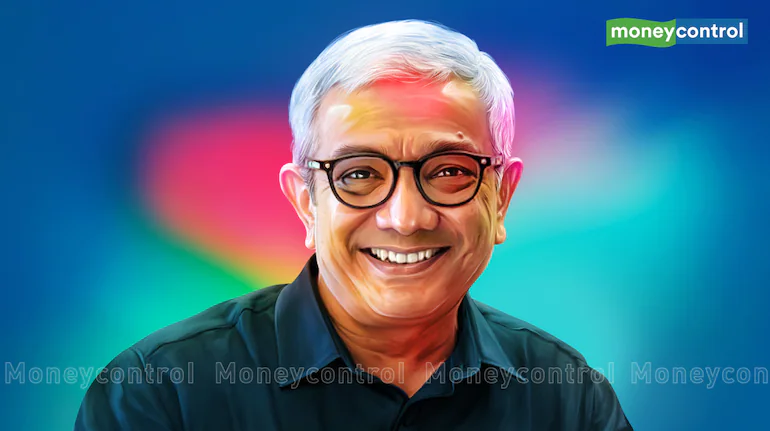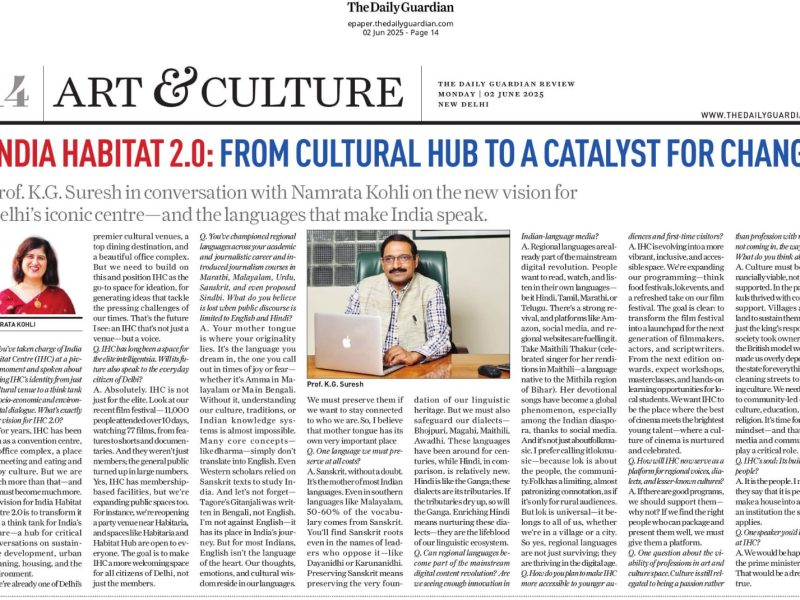Central Vista Project architect Bimal Patel says that projects with a historical context require meticulous research. So he tried to get inside Edwin Lutyens’s mind by studying books on history.
Bimal Patel is the man of the moment. He is the architect behind the Central Vista Redevelopment Project, the ongoing revamp of the Central Vista, India’s administrative nerve centre located near New Delhi’s Raisina Hill.
In an interview to Moneycontrol, Patel spoke about how the new design borrows from the architectural traditions of India, sustainability and how the building incorporates various craft traditions of the country.
What are the different elements of this project? For instance, one is revamping of the 3km Rajpath, from the Rashtrapati Bhavan to India Gate. What are the others?
The different elements of the Central Vista Redevelopment Project are the Kartavya Path (Central Vista Avenue), the new Parliament building, the Common Central Secretariat (CCS), the Executive Enclave—which will house the PMO (Prime Minister’s Office). The Vice-President’s (VP) Enclave will have his residence, administrative buildings, etc. Then we have the Prime Minister’s (PM) residence, chambers for members of Parliament (MP), a central conference centre, the Extension annexe to the National Archives, and the new IGNCA (Indira Gandhi National Centre for the Arts) building.
The Central Vista Project is a brownfield site. We are working with a site that is a living, operating, and fully functioning centre of administration. For this reason, the entire project has been planned in phases. The Kartavya Path, for example, was completed first so as not to disrupt public spaces and annual national events.
The new Parliament building is next, and construction work has already started on the first three CCS buildings. These will house the offices for the various ministries. This requires timelines to be sequenced in a manner that minimises any disruption to their work.
The North and South blocks will be converted into national museums. Since the Union government’s ministries are currently housed in these buildings, the CCS will need to be finished and the ministries relocated to the CCS first. Then, the North and South blocks will be restored and retrofitted, and artefacts will be moved into the two buildings.
All parts of the project have been planned in this manner so that we can meet deadlines without disrupting the functioning of the site.
What will happen to the old Parliament building, and what kind of museum is being created?
The old Parliament building is a marvelous piece of architecture, and it is also our collective heritage. The plan is to use it in conjunction with the new facility Parliament, as part of the Legislative Enclave. It will continue to house some offices and other facilities related to the Parliament.
What aspect of our heritage will the new design reflect?
The new design borrows its aesthetic language from the rich architectural traditions of India and from the old Parliament building. We have ensured continuity in the materials used on the exterior of the building, continuity in the colour schemes of the interiors. The building also incorporates various craft traditions of the country.
For the exteriors, we have used sandstone cladding and jaalis – both a throwback to the old architecture of Delhi, Lutyens’ language of materials, and traditional Indian construction. (In traditional Indian architecture, a jaali is a perforated, lattice screen of stone that cuts sunlight beautifully and creates lovely shifting patterns—as the sun moves—on the adjacent wall or floor.)
Coming to the interiors, the main hall of the Lok Sabha Chamber, where Parliament sits, is designed with green tones and abstracted forms of the peacock—our national bird.
The Rajya Sabha retains its red-brown colour scheme and has motifs inspired by the lotus—our national flower. Its courtyard will feature the banyan tree—our national tree. These symbols are widely known and accepted by all Indians, making the building relatable.
Moreover, various parts of India are featured. The sandstone has been quarried from Dholpur, and the granite from Lakha village in Jaisalmer. The carpets are being woven in Bhadohi in Uttar Pradesh, and in Kashmir. Intricate woodwork is being done by craftsmen from Maharashtra.
The building’s design pays homage to many such aspects of our traditional crafts and architecture.
Designing the new Parliament building means redesigning the nerve centre of governance. In a post-colonial society, what was your brief in designing for a new India?
I disagree. I am not redesigning any aspect of governance. I am only providing the space and the infrastructure for the government to function more efficiently. Our goal is to design a building that perfectly supports the functions of a Parliament.
It is true that the buildings we are working with and the site that we are designing at were a creation of the British Raj. But Indians, like many other post-colonial countries, adopted those buildings for their own use, and it cannot be denied that we connect and identify with those buildings.
The lawns, for example, which were originally formal gardens, became lively public spaces after Independence. Similarly, Kingsway, which was renamed Rajpath, and has now been renamed Kartavya Path, became the venue for our national events. When the North and South Blocks are converted into museums, people will be able to enter these buildings for the first time. This will change the iconography of power within this space.
Keeping this in mind, our approach was to provide modern and efficient infrastructure for the government, and quality public spaces for the people, while respecting the legacy of what was already there.
Did the exercise involve reading up history books to understand certain aspects? How did you try to maintain the historical aspect of the design?
Every project requires research—especially ones that have a historical context. We studied the history of the Central Vista and its various heritage buildings very meticulously. We wanted to know what Lutyens and Baker were envisioning. It meant reading history books like Robert Irving’s Indian Summer: Lutyens, Baker and Imperial Delhi, and Malvika Singh’s New Delhi: Making of a Capital, among others.
We also studied the existing buildings in detail. We made measured drawings of the spaces, the furniture, and the fixtures. We studied the services, the materials, and so on.
The historical aspect has been maintained in many ways. The master plan is based on the geometry proposed by Lutyens, the pattern of trees that we have planned for the next two decades at Kartavya Path is based on the original pattern. We have maintained continuity in material and colours, and we have adopted many details from the architectural traditions of India.

The revamped Kartavya Path is part of the Rs 13,450-crore Central Vista Redevelopment Project. (Image: AFP)
Was it easy to get craftsmen to replicate the old jaali work? What were the overall challenges you faced?
Jaalis are one of the details we adopted from traditional Indian architecture. The jaalis for the new parliament building have been cut by machines, not by hand. This ensures a lot of precision, and a good pace of production. However, the machine has limitations, especially with regard to the level of intricacy that can be achieved. Hence, we have optimised the design of the jaali so that it is conducive to mechanical production. We have abstracted the forms from historical references and simplified them.
Another challenge is making the jaalis robust. We have very large jaalis created by eliminating material from the whole, causing the structure to lose strength. To tackle this, we have reinforced the jaalis with a steel structure that is hidden from view behind the jaali. This makes them robust enough to withstand earthquakes, and ensures longevity.
Fixing in place elements like the plinth band, stone claddings, and carvings was also a challenge. Historically, these were fixed by applying mortar—this is called wet fixing. It takes time and has a tendency to fail in the long run as the mortar becomes weaker. So, instead of wet fixing, we used stainless steel clamps that hold the elements in place—this is called dry fixing. The process is faster, saves water, is safe, and has a much longer life than mortar.
How does your design and architecture address the issue of sustainability?
All the buildings that we have designed at Central Vista follow sustainable strategies of design.
Firstly, a building is sustainable if it is long-lasting. What makes a building last long is (of course) its strength, but also its capability to absorb change and allow for upgradation. If the building is not designed to do this, it will not remain functional for a long time, and that would not be sustainable.
Let me give you an example. We have designed the interior spaces of the upcoming CCS buildings in a modular fashion. This allows for the spaces to change and absorb rearrangement and some amount of expansion in future. It means that they will be able to accommodate the spatial needs of the offices for a long time.
Our buildings have been designed with easily replaceable services. If you can upgrade the services of a building easily, it’s a sustainable design. For example, if a building is, say, 300 years old, it’s not as if the entire building is 300 years old. The doors might be 10 years old, the lights may be a couple of years old, and so on. It is the structure that is 300 years old. Therefore, if we build a strong structure and add services that can be easily replaced, the building remains sustainable. All the new buildings at the Central Vista follow this concept.
Secondly, a complex is sustainable if it consolidates the infrastructure. This enables shared use of services such as air-conditioning, and of common spaces like conference rooms, convention centres, toilets, and cafes. By consolidating the ministry offices and conference spaces at the Central Vista, we have also consolidated the services that they use. This reduces the net energy consumption, and the energy and time that is spent commuting between buildings.
Thirdly, sustainability also depends on the fixtures one uses in buildings. All the buildings that we are designing on the Central Vista use energy-efficient fixtures.
Additionally, the entire development is transit-oriented. An underground people-mover and a shuttle bus above-ground connect the CCS buildings. These are in turn connected with the nearby Central Secretariat Metro station, making it easy to use public transport.




